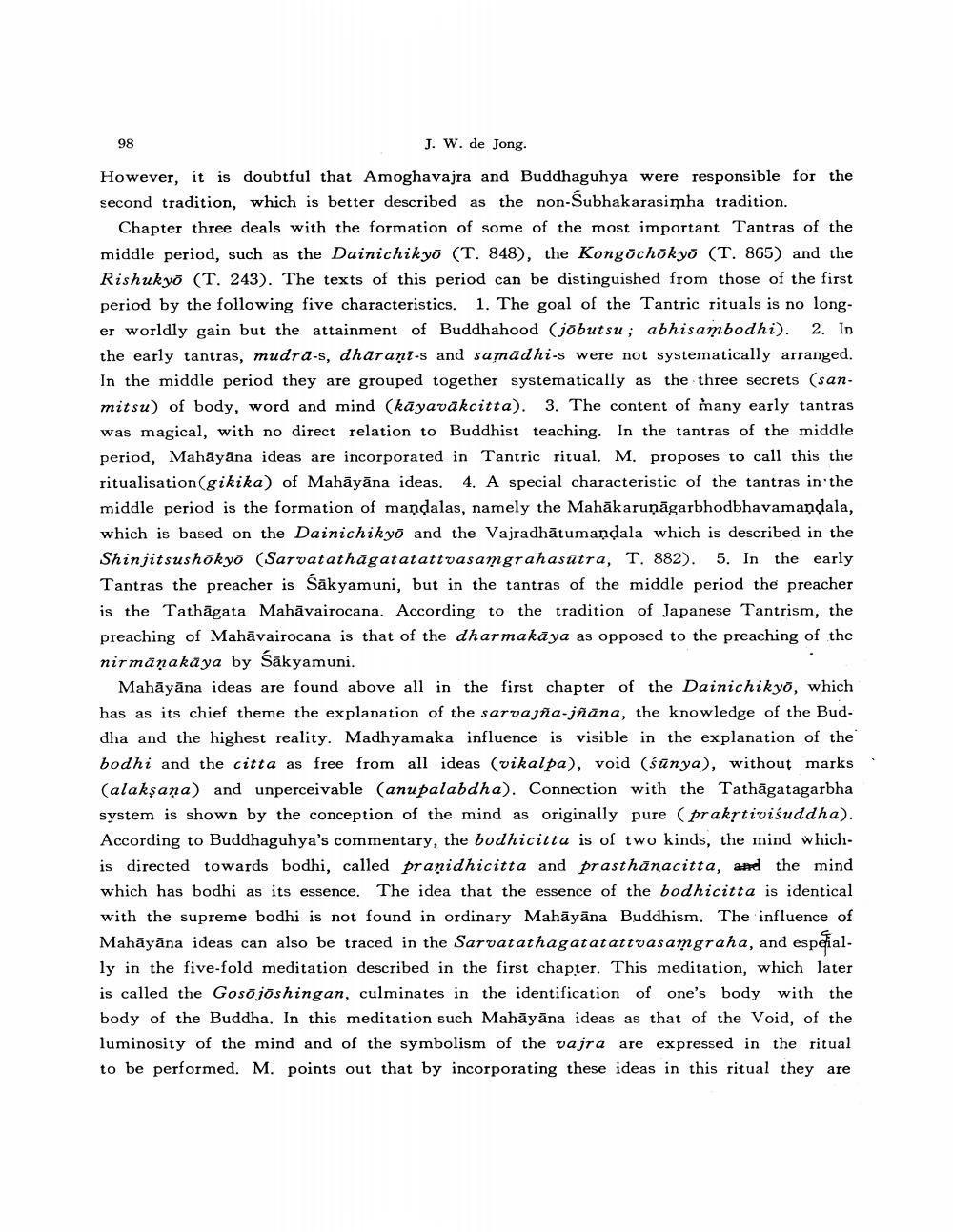Book Title: New History Of Tantric Lieterature In India Author(s): J W De Jong Publisher: J W De Jong View full book textPage 8
________________ 98 J. W. de Jong However, it is doubtful that Amoghavajra and Buddhaguhya were responsible for the second tradition, which is better described as the non-Subhakarasimha tradition. Chapter three deals with the formation of some of the most important Tantras of the middle period, such as the Dainichikyo (T. 848), the Kongochokyo (T. 865) and the Rishukyo (T. 243). The texts of this period can be distinguished from those of the first period by the following five characteristics. 1. The goal of the Tantric rituals is no longer worldly gain but the attainment of Buddhahood (jõbutsu ; abhisambodhi). 2. In the early tantras, mudra-s, dhāraņi-s and samadhi-s were not systematically arranged. In the middle period they are grouped together systematically as the three secrets (san. mitsu) of body, word and mind (kāyavākcitta). 3. The content of many early tantras was magical, with no direct relation to Buddhist teaching. In the tantras of the middle period, Mahāyāna ideas are incorporated in Tantric ritual. M. proposes to call this the ritualisation(gikika) of Mahāyāna ideas. 4. A special characteristic of the tantras in the middle period is the formation of mandalas, namely the Mahākaruņāgarbhodbhavamandala, which is based on the Dainichikyo and the Vajradhātumandala which is described in the Shinjitsushokyo (Sarvatathāgatatattvasamgrahasūtra, T. 882). 5. In the early Tantras the preacher is Sākyamuni, but in the tantras of the middle period the preacher is the Tathāgata Mahāvairocana. According to the tradition of Japanese Tantrism, the preaching of Mahāvairocana is that of the dharmakāya as opposed to the preaching of the nirmāņakaya by Sākyamuni. Mahāyāna ideas are found above all in the first chapter of the Dainichikyo, which has as its chief theme the explanation of the sarvajña-jñāna, the knowledge of the Buddha and the highest reality. Madhyamaka influence is visible in the explanation of the bodhi and the citta as free from all ideas (vikalpa), void (śünya), without marks (alakşaņa) and unperceivable (anupalabdha). Connection with the Tathāgatagarbha system is shown by the conception of the mind as originally pure (prakstiviśuddha). According to Buddhaguhya's commentary, the bodhicitta is of two kinds, the mind whichis directed towards bodhi, called pranidhicitta and prasthānacitta, and the mind which has bodhi as its essence. The idea that the essence of the bodhicitta is identical with the supreme bodhi is not found in ordinary Mahāyāna Buddhism. The influence of Mahāyāna ideas can also be traced in the Sarvatathāgatatattvasamgraha, and espeially in the five-fold meditation described in the first chapter. This meditation, which later is called the Gosājoshingan, culminates in the identification of one's body with the body of the Buddha. In this meditation such Mahāyāna ideas as that of the Void, of the luminosity of the mind and of the symbolism of the vajra are expressed in the ritual to be performed. M. points out that by incorporating these ideas in this ritual they arePage Navigation
1 ... 6 7 8 9 10 11 12 13 14 15 16 17 18 19 20 21 22 23
